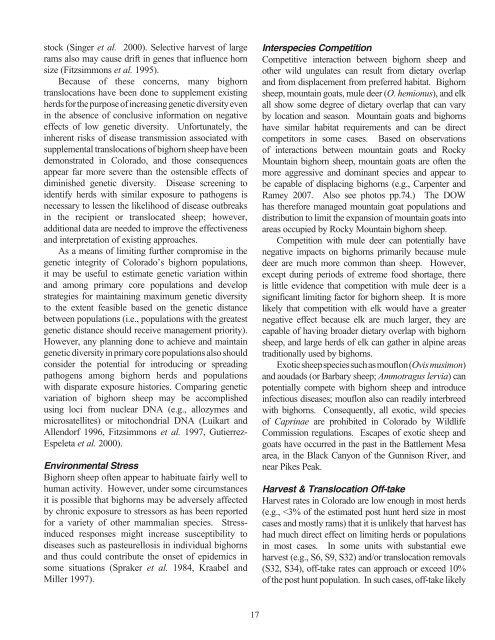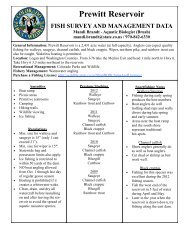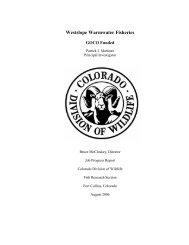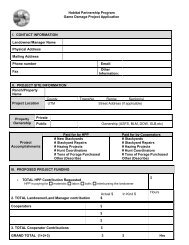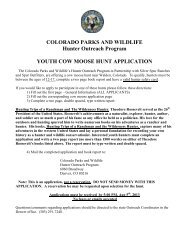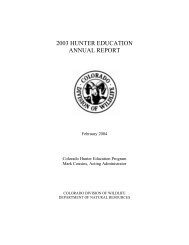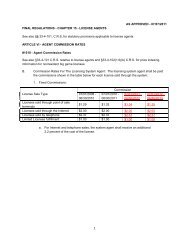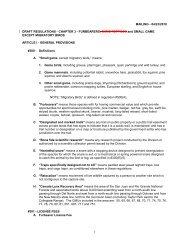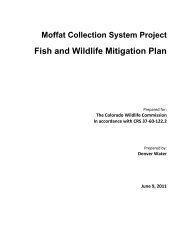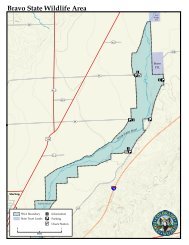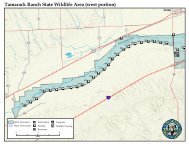COLORADO BIGHORN SHEEP MANAGEMENT PLAN 2009−2019
COLORADO BIGHORN SHEEP MANAGEMENT PLAN 2009−2019
COLORADO BIGHORN SHEEP MANAGEMENT PLAN 2009−2019
You also want an ePaper? Increase the reach of your titles
YUMPU automatically turns print PDFs into web optimized ePapers that Google loves.
stock (Singer et al. 2000). Selective harvest of large<br />
rams also may cause drift in genes that influence horn<br />
size (Fitzsimmons et al. 1995).<br />
Because of these concerns, many bighorn<br />
translocations have been done to supplement existing<br />
herds for the purpose of increasing genetic diversity even<br />
in the absence of conclusive information on negative<br />
effects of low genetic diversity. Unfortunately, the<br />
inherent risks of disease transmission associated with<br />
supplemental translocations of bighorn sheep have been<br />
demonstrated in Colorado, and those consequences<br />
appear far more severe than the ostensible effects of<br />
diminished genetic diversity. Disease screening to<br />
identify herds with similar exposure to pathogens is<br />
necessary to lessen the likelihood of disease outbreaks<br />
in the recipient or translocated sheep; however,<br />
additional data are needed to improve the effectiveness<br />
and interpretation of existing approaches.<br />
As a means of limiting further compromise in the<br />
genetic integrity of Colorado’s bighorn populations,<br />
it may be useful to estimate genetic variation within<br />
and among primary core populations and develop<br />
strategies for maintaining maximum genetic diversity<br />
to the extent feasible based on the genetic distance<br />
between populations (i.e., populations with the greatest<br />
genetic distance should receive management priority).<br />
However, any planning done to achieve and maintain<br />
genetic diversity in primary core populations also should<br />
consider the potential for introducing or spreading<br />
pathogens among bighorn herds and populations<br />
with disparate exposure histories. Comparing genetic<br />
variation of bighorn sheep may be accomplished<br />
using loci from nuclear DNA (e.g., allozymes and<br />
microsatellites) or mitochondrial DNA (Luikart and<br />
Allendorf 1996, Fitzsimmons et al. 1997, Gutierrez-<br />
Espeleta et al. 2000).<br />
Environmental Stress<br />
Bighorn sheep often appear to habituate fairly well to<br />
human activity. However, under some circumstances<br />
it is possible that bighorns may be adversely affected<br />
by chronic exposure to stressors as has been reported<br />
for a variety of other mammalian species. Stressinduced<br />
responses might increase susceptibility to<br />
diseases such as pasteurellosis in individual bighorns<br />
and thus could contribute the onset of epidemics in<br />
some situations (Spraker et al. 1984, Kraabel and<br />
Miller 1997).<br />
17<br />
Interspecies Competition<br />
Competitive interaction between bighorn sheep and<br />
other wild ungulates can result from dietary overlap<br />
and from displacement from preferred habitat. Bighorn<br />
sheep, mountain goats, mule deer (O. hemionus), and elk<br />
all show some degree of dietary overlap that can vary<br />
by location and season. Mountain goats and bighorns<br />
have similar habitat requirements and can be direct<br />
competitors in some cases. Based on observations<br />
of interactions between mountain goats and Rocky<br />
Mountain bighorn sheep, mountain goats are often the<br />
more aggressive and dominant species and appear to<br />
be capable of displacing bighorns (e.g., Carpenter and<br />
Ramey 2007. Also see photos pp.74.) The DOW<br />
has therefore managed mountain goat populations and<br />
distribution to limit the expansion of mountain goats into<br />
areas occupied by Rocky Mountain bighorn sheep.<br />
Competition with mule deer can potentially have<br />
negative impacts on bighorns primarily because mule<br />
deer are much more common than sheep. However,<br />
except during periods of extreme food shortage, there<br />
is little evidence that competition with mule deer is a<br />
significant limiting factor for bighorn sheep. It is more<br />
likely that competition with elk would have a greater<br />
negative effect because elk are much larger, they are<br />
capable of having broader dietary overlap with bighorn<br />
sheep, and large herds of elk can gather in alpine areas<br />
traditionally used by bighorns.<br />
Exotic sheep species such as mouflon (Ovis musimon)<br />
and aoudads (or Barbary sheep; Ammotragus lervia) can<br />
potentially compete with bighorn sheep and introduce<br />
infectious diseases; mouflon also can readily interbreed<br />
with bighorns. Consequently, all exotic, wild species<br />
of Caprinae are prohibited in Colorado by Wildlife<br />
Commission regulations. Escapes of exotic sheep and<br />
goats have occurred in the past in the Battlement Mesa<br />
area, in the Black Canyon of the Gunnison River, and<br />
near Pikes Peak.<br />
Harvest & Translocation Off-take<br />
Harvest rates in Colorado are low enough in most herds<br />
(e.g.,


